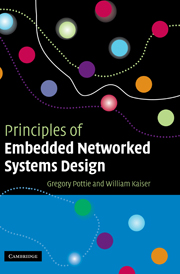Book contents
- Frontmatter
- Contents
- Preface
- Acknowledgments
- List of Abbreviations
- 1 Embedded network systems
- 2 Representation of signals
- 3 Signal propagation
- 4 Sensor principles
- 5 Source detection and identification
- 6 Digital communications
- 7 Multiple source estimation and multiple access communications
- 8 Networking
- 9 Network position and synchronization services
- 10 Energy management
- 11 Data management
- 12 Articulation, mobility, and infrastructure
- 13 Node architecture
- 14 Network data integrity
- 15 Experimental systems design
- 16 Ethical, legal, and social implications of ENS
- 17 Design principles for ENS
- Appendix A Gaussian Q function
- Appendix B Optimization
- Index
4 - Sensor principles
Published online by Cambridge University Press: 10 August 2009
- Frontmatter
- Contents
- Preface
- Acknowledgments
- List of Abbreviations
- 1 Embedded network systems
- 2 Representation of signals
- 3 Signal propagation
- 4 Sensor principles
- 5 Source detection and identification
- 6 Digital communications
- 7 Multiple source estimation and multiple access communications
- 8 Networking
- 9 Network position and synchronization services
- 10 Energy management
- 11 Data management
- 12 Articulation, mobility, and infrastructure
- 13 Node architecture
- 14 Network data integrity
- 15 Experimental systems design
- 16 Ethical, legal, and social implications of ENS
- 17 Design principles for ENS
- Appendix A Gaussian Q function
- Appendix B Optimization
- Index
Summary
The fundamental characteristics of sensor systems provide some of the most important features that distinguish embedded networked sensors from other computing platforms. It is the nature of sensor systems that defines the information acquisition performance of ENS devices, the required spatiotemporal distribution of sensors, and architectural requirements including energy dissipation.
This chapter describes the fundamental principles of sensor technology that are required by the ENS designer. This includes first the architecture of ideal sensors. Then, the characteristics of non-ideal sensors and definitions for sensor figures of merit are provided. These figures of merit are critical in enabling a comparison of sensor performance and for the design of ENS systems. Then, the properties of sensors are illustrated through discussion of environmental sensors, chemical (gas-phase) sensors, and finally electromechanical sensor systems. This also includes discussion on the topics of transducer scaling to small size and sources of sensor system noise.
It is not possible in this introductory treatment to describe all possible types of sensors. The aim is to provide some intuition on microsensor properties and operation to enable selection of microsensors for signal monitoring and control. From a knowledge of measurement methods with their advantages and limitations, the goal of this chapter is to provide the designer with the set of considerations for selecting sensor systems for interfacing the mechanical, electromagnetic, and chemical environment to low-cost data acquisition, processing, and control systems.
Information
- Type
- Chapter
- Information
- Principles of Embedded Networked Systems Design , pp. 61 - 108Publisher: Cambridge University PressPrint publication year: 2005
